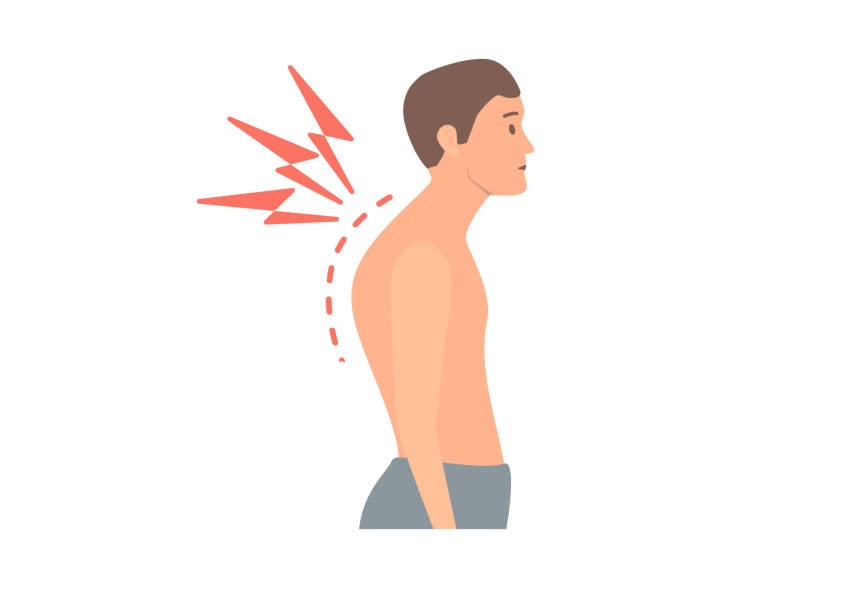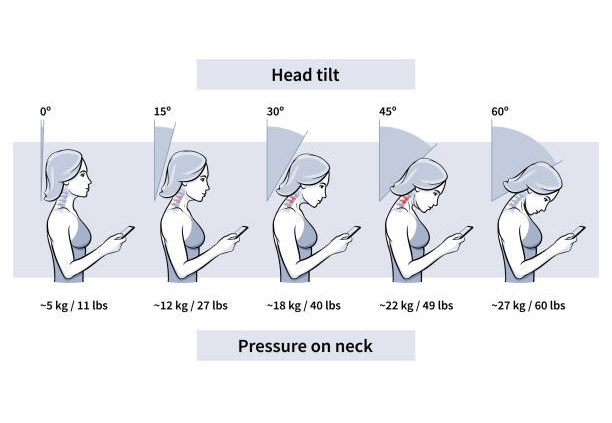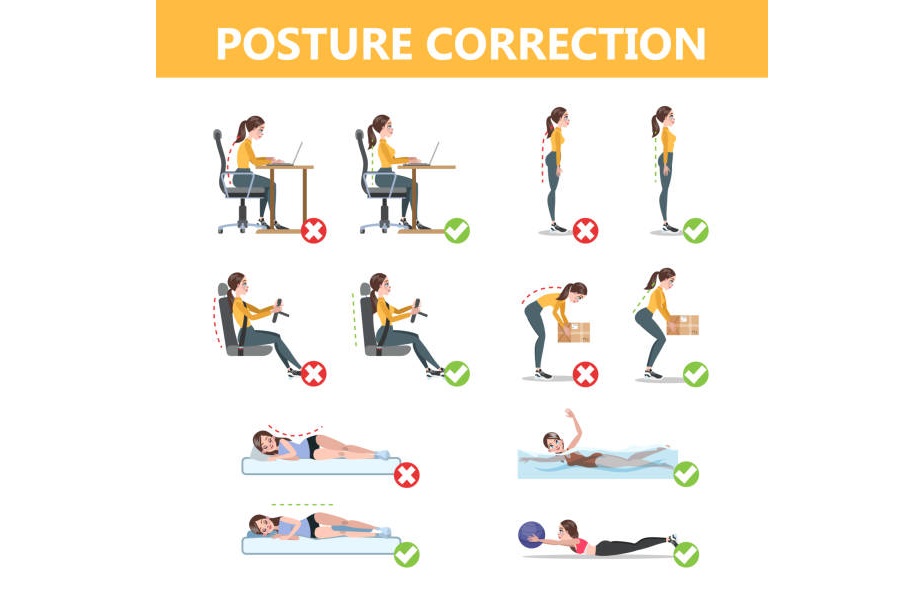Table of Contents
Poor posture from too much sitting wreaks havoc on your muscle balance, joint alignment, and movement patterns. Left unchecked, it cascades into chronic pain, restricted mobility, and heightened injury risk.
The good news is that targeted corrective exercises can reverse postural dysfunctions by realigning the body and integrating muscle groups. Dedicated training returns you to pain-free performance.
In this comprehensive guide, we’ll break down the ideal corrective exercises to fix the most common postural imbalance issues. You’ll be able to design targeted routines to tackle rounded shoulders, forward head posture, excessive kyphosis, and more.
Let’s dive in and start moving better!
Common Posture Imbalances Explained
Before diving into corrective strategies, let’s overview the main suboptimal posture patterns:
1. Rounded Shoulders

Rounded shoulders occur when your thoracic spine curvature is exaggerated and shoulders roll forward. This compresses your chest and can irritate surrounding tissues.
– Causes
Weak upper back muscles
Tight chest muscles
Too much desk work and phone use
2. Forward Head Posture

Forward head posture is when your head sits too far in front of your body rather than stacking properly atop your spine. This strains your neck and upper back.
– Causes
Weak deep neck flexors
Tight chest and shoulders
Forward shoulder rounding
3. Excessive Kyphosis

Also called thoracic hyperkyphosis, this involves an excessive curvature in your upper back/thoracic area. Daily slouching worsens this rounded posture.
– Causes
Weak thoracic extensors like rhomboids
Short chest muscles
Poor thoracic mobility
4. Anterior Pelvic Tilt

Anterior pelvic tilt describes an excessive arch in your lower back with your pelvis tipped forward. This strains your lumbar spine and low back.
– Causes
Tight hip flexors and lower back
Weak glutes and abdominals
Too much sitting
Now let’s break down targeted corrective exercises that can remedy each dysfunctional pattern.
Corrective Exercises for Rounded Shoulders
Here are the most effective corrective moves to combat rounded shoulders and strengthen your upper back:
1. Face Pulls
Using resistance bands or a cable machine, drive your elbows back powerfully to pinch your shoulder blades. Emphasize the retraction.
2. Band Pull Aparts
With a band at chest height, pull your hands out laterally to engage the rear delts. Pause each rep.
3. Prone Y Raises
Lying on your stomach, raise your arms in a Y shape focusing on pinching the shoulder blades up and back.
4. Band External Rotations
Hold a band at hip height and rotate your hands outward, pulling your shoulder blades back.
5. Wall Slides
Slide your arms upward toward the ceiling like climbing the wall. Keep full shoulder blade retraction the whole time.
6. Chin Tucks
Press the back of your head against a stability ball on the wall to strengthen your deep neck flexors.
Corrective Exercises for Forward Head Posture
These movements strengthen the weak postural muscles and mobilize tight ones causing forward head issues:
1. Upper Trap Stretches
Gently stretch your upper traps by tilting your ear sideways toward each shoulder. Hold 30 seconds per side.
2. Chin Tucks
Press the back of your head into a stability ball on the wall to activate the deep neck flexors.
3. Thoracic Extension Mobilizations
Foam roll or peanut on your upper back. You can lie over a stability ball as well. Mobilize tight thoracic tissues.
4. Banded Shoulder Retractions
Pull a resistance band back powerfully while pinching your shoulder blades together.
5. Face Pulls
Using resistance bands or a cable machine, drive your elbows back to engage your upper back.
Corrective Exercises for Excessive Kyphosis
These moves target posture muscles like the rhomboids and thoracic extensors:
1. Band Pull Aparts
Hold a resistance band at chest height and draw your hands outward to pinch your shoulder blades back.
2. Band Rows
Row a band back powerfully by squeezing your shoulder blades together. Focus on rhomboid activation.
3. Wall Angels
Slide your arms up and down a wall while keeping full shoulder blade retraction.
4. Supermans
Lying face down, simultaneously raise your arms and legs to strengthen your back extensors.
5. Y, T, W’s
While lying face down, trace the letters Y, T, and W with your arms to hit all scapular positions.
Corrective Exercises for Anterior Pelvic Tilt
These movements counteract the muscular pattern causing you to tilt your pelvis forward:
1. Glute Bridges
Drive through your heels to raise your hips high, squeezing your glutes at the top.
2. Deadbugs
Laying on your back, slowly extend your legs and opposite arm. Keep your lower back pressed down.
3. Planks
Stay neutral and brace your core during front and side plank variations. Keep your hips down.
4. Glute Kickbacks
Kick your leg back, squeezing your glute. Make sure to keep your hips square.
5. Bird Dogs
From all fours extend your opposite arm and leg, keeping your hips still.
Implementing a Corrective Routine

Now it’s time to develop a comprehensive corrective routine targeting your specific posture issues. Follow these tips:
- See a physiotherapist or posture expert for evaluation if needed. Get prescribed exercises.
- Focus on body awareness during all movements. Move smoothly and control momentum.
- Start with higher rep sets like 12-15 to repattern muscle firing. Build up overtime.
- Increase difficulty slowly over weeks and months as positions improve. Progress load and range of motion.
- Perform mini-corrective routines 2-3x per day after long periods of sitting or inactivity.
- Do 4-5x longer targeted sessions per week of full-range strengthening moves.
- Maintain good form – poor mechanics during correctives undermine their purpose.
- Monitor progress monthly with photos and measurements of posture angles.
Sample Corrective Exercise Programs

Here are two sample corrective routines to improve common postural dysfunction patterns:
Rounded Shoulders Program
- A1) Band Pull Aparts 3×15
- A2) Band External Rotations 3×12
- B1) Face Pulls 3×10
- B2) Prone Y Raises 3×10
- C1) Upper Trap Stretches 2x30sec
Forward Head Posture Program
- A1) Chin Tucks 3×10-15
- A2) Thoracic Extensions 3×8-10
- B1) Banded Shoulder Retractions 3×12-15
- B2) Upper Trap Stretches 2x30sec
- C1) Face Pulls 3×10
Perform these routines 2-3x per week after warming up. Let pain and fatigue guide you – modify if exercises irritate or exacerbate issues. Consistency over months is key for rebalancing posture.
Nutrition and Lifestyle Tips for Improving Posture

Exercises get you halfway – you must also address poor posture habits:
- Maintain torso bracing when sitting or standing all day. Remind yourself.
- Take regular breaks from your desk or phone to change positions often.
- Limit screen time especially hunched over in bed – keep your neck neutral.
- Improve thoracic mobility with foam rolling, massage, and yoga poses like a child’s pose.
- Strengthen your core with planks, dead bugs, and farmers’ carries. A strong core supports proper spinal alignment.
- Check your nutrition – get enough protein for muscle repair and bone-supporting nutrients like calcium.
- Manage stress levels that manifest in tense muscles and compressed posture.
Bottom Line
Bad posture develops over years of less-than-ideal lifestyle and movement patterns. The good news is that targeted corrective exercises done consistently can undo the damage and muscle imbalances.
Train pulling and retracting motions to combat rounded shoulders. Chin tucks and thoracic extensions fix forward head issues. Maximize scapular retraction to lessen kyphosis. Strengthen your glutes, abs, and hamstrings to counter anterior pelvic tilt.
Coupled with mobility work, bracing, stress management, and nutrition, your posture will improve allowing you to move and feel your best again. Let me know if you have any other questions!

